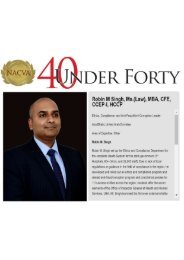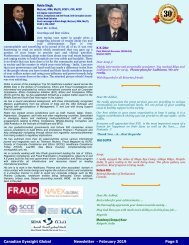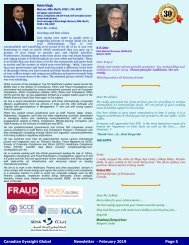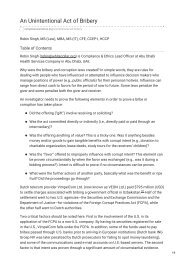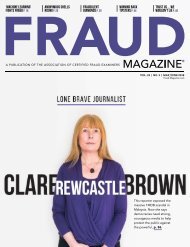Anti-bribery programs: A web of ethical and legal dilemmas
The role of the #iso37001 in curbing the #corruption and safeguarding organizations from #legal exposure with #robinsingh and #SCCE (Society of Corporate Compliance and Ethics)See Less by #RobinSingh the #whitecollarinvestigator
The role of the #iso37001 in curbing the #corruption and safeguarding organizations from #legal exposure with #robinsingh and #SCCE (Society of Corporate Compliance and Ethics)See Less by #RobinSingh the #whitecollarinvestigator
Create successful ePaper yourself
Turn your PDF publications into a flip-book with our unique Google optimized e-Paper software.
<strong>of</strong> the term. This is because <strong>bribery</strong> is<br />
defined by a country’s own national laws<br />
<strong>and</strong>, therefore, the definition <strong>of</strong> <strong>bribery</strong><br />
inevitably varies between countries. For<br />
example, the Foreign Corrupt Practices<br />
Act does not see facilitation payments as<br />
bribes. However, the UK<br />
Bribery Act considers<br />
facilitation payments as<br />
il<strong>legal</strong>. In comparison, in<br />
the Middle East, the big<br />
booming oil economies<br />
charge a fee to expedite<br />
the process. This shows<br />
that countries may have<br />
various definitions <strong>of</strong><br />
what can or cannot be<br />
considered as a bribe.<br />
Using the ISO st<strong>and</strong>ard<br />
to measure a compliance program<br />
Although there are numerous practices that<br />
exist to measure a compliance program or<br />
an anti-<strong>bribery</strong> <strong>and</strong> corruption program, an<br />
ISO st<strong>and</strong>ard is treated as a gold st<strong>and</strong>ard<br />
for an organization. With any type <strong>of</strong><br />
compliance program, including ISO 37001,<br />
it is key to have established metrics that<br />
allow you to measure the effectiveness<br />
<strong>of</strong> a compliance program. Wellconstructed<br />
metrics facilitate performance<br />
improvement, effectiveness, efficiency, <strong>and</strong><br />
appropriate levels <strong>of</strong> internal control. The<br />
sources are a very important element <strong>of</strong><br />
these metrics, such as:<br />
· Regulatory sources, including laws,<br />
regulators, etc.<br />
· Non-regulatory sources, including<br />
policies, guidelines, etc.; <strong>and</strong><br />
· Other sources, which should ideally<br />
incorporate international leading<br />
practices relevant to the st<strong>and</strong>ard that<br />
is being measured as well as cost/risk/<br />
benefit analysis, when appropriate.<br />
Metrics are key to the<br />
overall success <strong>of</strong> a<br />
compliance program,<br />
so it is worth spending<br />
the time <strong>and</strong> energy<br />
to come up with the<br />
right metrics.<br />
During the implementation stage,<br />
there should be some objective metrics<br />
that provide insight into an organization’s<br />
progress toward meeting a specific goal or<br />
milestone in the implementation <strong>of</strong> an anticorruption<br />
policy.<br />
It is also very<br />
important to<br />
categorize these<br />
matrices <strong>and</strong> their<br />
applicability. One<br />
size cannot fit all,<br />
<strong>and</strong> thus, ideally,<br />
some metrics should<br />
be focused on the<br />
effectiveness <strong>of</strong> the<br />
program <strong>and</strong> some<br />
separate metrics<br />
should focus on the<br />
efficiency <strong>of</strong> your<br />
program. The bottom line is that every<br />
line item needs to be objectively quantified<br />
irrespective <strong>of</strong> the subjectivity <strong>of</strong> the matter<br />
(e.g., the number <strong>of</strong> calls to the corporate<br />
hotline, the percentage <strong>of</strong> employees who<br />
complete their trainings, or the number <strong>of</strong><br />
lawsuits filed against the organization).<br />
Thus, subjective measurements<br />
should be avoided, because they are<br />
inherently problematic. With metrics that<br />
can be objectively measured, it is easy to<br />
benchmark your program against specific<br />
st<strong>and</strong>ards. Numerical metrics can be<br />
particularly advantageous in this sense,<br />
allowing for trend <strong>and</strong> statistical analysis<br />
to see how the implementation <strong>of</strong> your<br />
compliance program is progressing <strong>and</strong><br />
how the program is performing once it is<br />
established <strong>and</strong> running. With subjective<br />
measurements, this becomes unfeasible.<br />
Metrics are key to the overall success<br />
<strong>of</strong> a compliance program, so it is worth<br />
spending the time <strong>and</strong> energy to come up<br />
with the right metrics. Some <strong>of</strong> the key<br />
Compliance & Ethics Pr<strong>of</strong>essional ® June 2017<br />
+1 952 933 4977 or 888 277 4977 www.corporatecompliance.org 63







